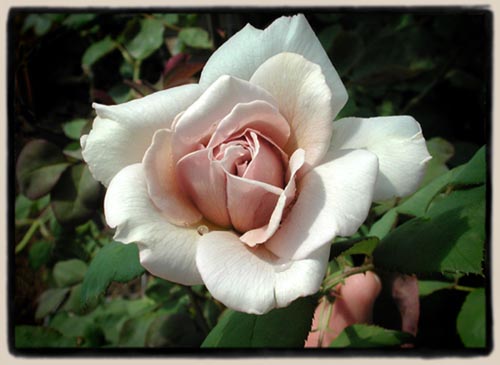 |
|
Albas |
'Gray Pearl', bred by McGredy, 1945.
As its name suggests, this is a gray rose. The bloom is an odd combination of soft tan and pale mauve wich gives an overall impression of gray. Bloom form is fully double and large, at about 4 inches or more and there is definitely a good fragrance of undefined character, quite befitting this odd rose. It is classed as a Hybrid Tea, and in 1945 when it was introduced, it was considered to be a fore-runner of the "blue" roses. It sired several well known cool mauve hybrids, including 'Lavender Pinocchio'. This rose will NOT be everyone's cup of tea, but I like it. Sam McGredy, who doesn't like this rose, has been quoted as saying "The rose was raised on my nursery and the colour is a cross between slightly used toilet paper and the skin of a dead mouse. As far as my family was concerned the rose was a poor grower and an appalling colour. BUT, Gene Boerner the hybridiser for Jackson & Perkins was ecstatic - here was something new and different. We nicknamed it The Mouse. He came up with the name Grey Pearl and the beautiful US$ that came with it." Sam McGredy 'Gray Pearl' requires special cultivation to prosper. How much special culture? Purchase a grafted plant, for starters.....own roots are even more difficult. This rose must be allowed to build up a maximum of infrastructure, especially during its first 2 years. In its first year, it is recommended that it be allowed to produce no more than a couple or three blooms and force the plant to make growth to support future blooms. Everyone who has any experience with 'Gray Pearl' will tell you that it is a cultivar that will bloom itself to death if you allow it to. Mine is now 3 years old, and it is only now that I will allow it to bloom almost to its heart's content. I still pinch out maybe 25% of its buds, so as to not tax it excessively. As for pruning, it shouldn't be cut any more than simply deadheading it: remove only the spent bloom, and at most, one node below the flower. Every leaf is highly valuable and must be left on the plant to get the most out of it. Only once the older wood becomes darkened and unhealthy looking should you start cutting wood out of the plant. The key is gradual replacement of infrastructure wood. As for general culture, this plant must be fed almost excessively to thrive. Soil conditions should be as ideal as possible. (Mine lives in a large tub, so I have control over soil quality, drainage, etc) Fertilize it as much as you dare, and keep the plant free from disease, always. That includes mildew. (Mine is in a greenhouse, and has a tendency to mildew and must be sprayed to prevent this) Give it alfalfa meal/pellets. Give it Superthrive. Give it as much Nitrogen as you dare. (within reason) Give it Epsom Salts too, for that matter. It will take most anything you can throw at it, and will prosper as a result. Mind you, I'm not advocating anything that exceeds manufacturer's recommended dosages, as far as fertilizer products is concerned, ok? Always follow directions, but give the maximum that is allowed. So, this is what I term "high culture". Climate will play a role as well, no doubt, and so the California growers are going to have a distinct advantage over those in Maine, especially when we are talking about 'Gray Pearl'. Luck and cisrcumstance will play a part, but cultivation is a major factor as well. That being said, I would not part with my 'Gray Pearl' for love nor money. When it is happy, it is mindbendingly beautiful. I got mine from The Uncommon Rose. ARS
merit rating:
4.9 (indicates that it needs highest culture to prosper) Original photographs and site content © Paul Barden 2005, All Rights Reserved.
|
|

 One
of the more obscure roses I grow is McGredy's 'Grey Pearl', also
known as 'The Mouse', which I have been fortunate to obtain this year.
It is almost non-existant in commerce now, likely because of its odd
color and somewhat fussy constitution. It is slow to develop into a
mature plant and should have its buds removed for at least the first
year in order to build up some sturdy wood. My plant is grown on its
own roots and is doing well, but apparently it is best grown as a budded
rose.
One
of the more obscure roses I grow is McGredy's 'Grey Pearl', also
known as 'The Mouse', which I have been fortunate to obtain this year.
It is almost non-existant in commerce now, likely because of its odd
color and somewhat fussy constitution. It is slow to develop into a
mature plant and should have its buds removed for at least the first
year in order to build up some sturdy wood. My plant is grown on its
own roots and is doing well, but apparently it is best grown as a budded
rose.